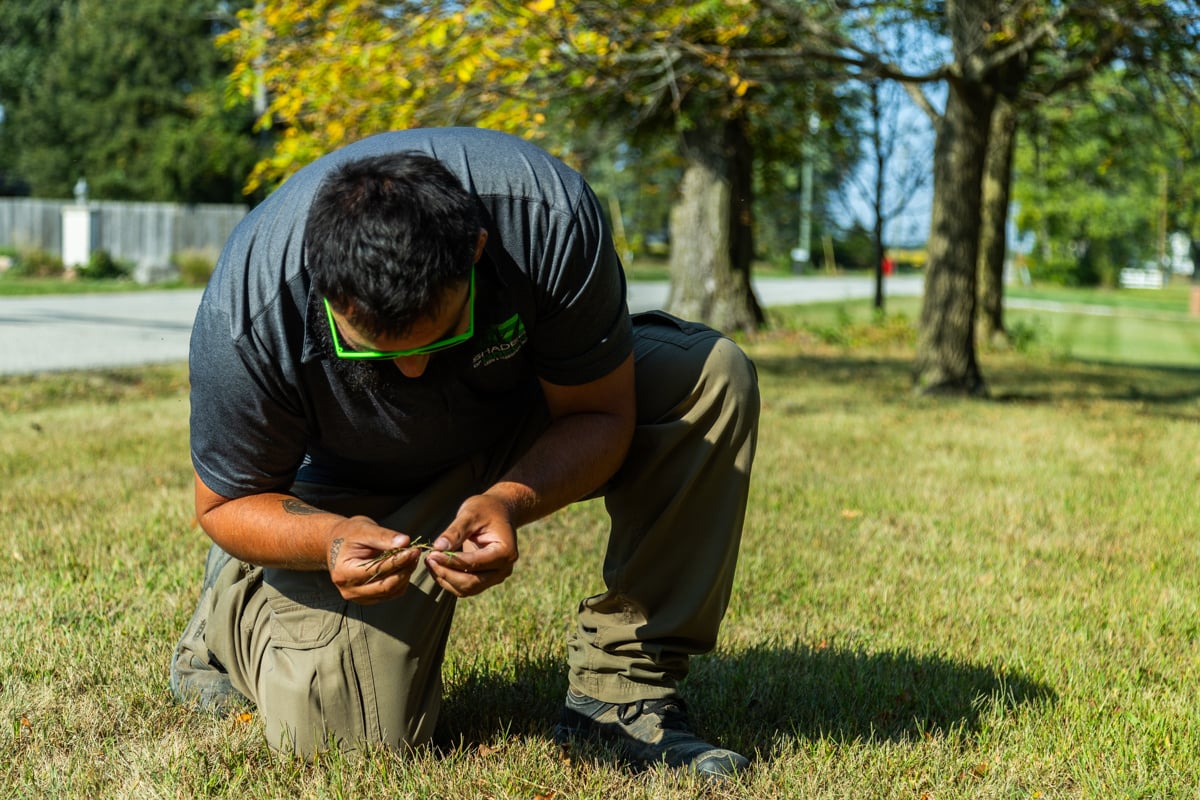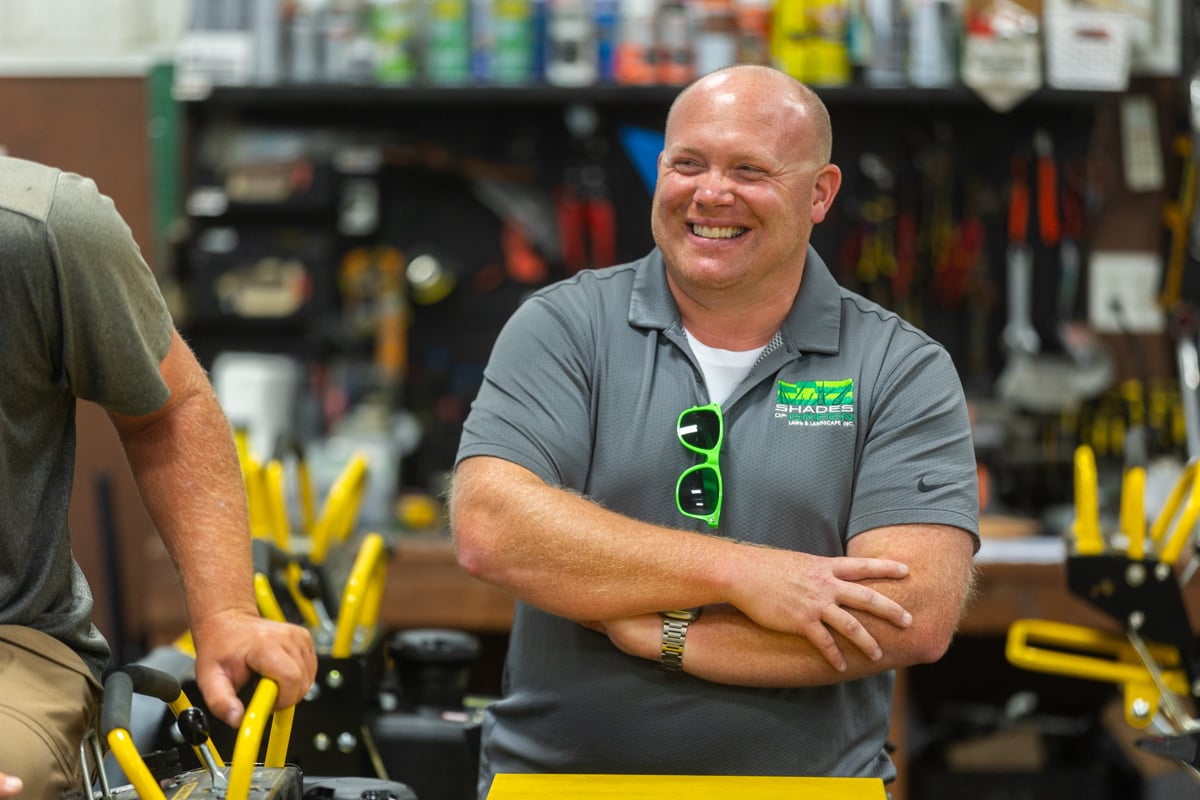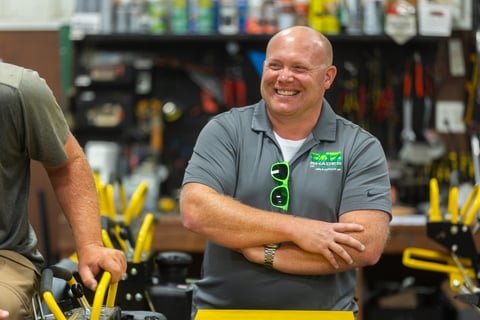
5 Common Lawn Weeds in Indiana: How to Identify and Prevent

Tired of turning your backyard into a battlefield against lawn weeds? We get it.
Those pesky invaders don’t just show up out of nowhere – they sneak into weak spots in your grass, steal nutrients, and turn your once-thriving lawn into a patchy mess. But fear not!
In this blog, we’re breaking down the top five most common lawn weeds in Indiana, how to identify them, and most importantly the overall impact they have on your turf.
The Big 5 of Lawn Weeds in Indiana
Lawn weeds are more than just an eyesore; they compete with your grass for nutrients, water, and sunlight, slowly sabotaging your turf. Understanding the most common culprits and how they thrive is the first step in taking back control of your lawn. Let’s dive deeper into the five most common lawn weeds in Indiana.
Dandelions
Dandelions are easy to spot with their bright yellow flowers that turn into fluffy white seed heads. Their jagged-edged leaves grow in a rosette pattern close to the ground.
Unfortunately, these weeds pop up everywhere – from lush lawns to neglected patches of grass, especially in sunny or slightly shaded areas. Dandelions love anything from disturbed soil to areas with compacted or nutrient-poor soil. They thrive in lawns with thin or patchy grass where they have plenty of space to grow.
Dandelions love anything from disturbed soil to areas with compacted or nutrient-poor soil. They thrive in lawns with thin or patchy grass where they have plenty of space to grow.
While their cheerful flowers might look harmless, dandelions spread aggressively through their lightweight seeds. They compete for space, nutrients, and moisture, making it harder for your grass to thrive. Plus, their deep roots are tough to remove entirely, meaning they often return if not dealt with properly.
Clover
Clover forms low-growing mats of small, three-lobed leaves and often has white or pinkish flowers. You’ll find clover in areas with compacted soil, under-fertilized lawns, or spots where grass struggles to grow. Clover thrives in nitrogen-deficient soils, as it can pull nitrogen from the air using its root nodules. This gives it a competitive edge in lawns where grass lacks nutrients. Lawns filled with clover typically indicate that your lawn is hungry!
Clover thrives in nitrogen-deficient soils, as it can pull nitrogen from the air using its root nodules. This gives it a competitive edge in lawns where grass lacks nutrients. Lawns filled with clover typically indicate that your lawn is hungry!
While some homeowners like the look of clover, it can be a sign of low nitrogen. It can quickly spread and outcompete grass, creating uneven textures in your lawn. Its presence also signals the need to adjust your lawn care routine to restore balance.
Crabgrass
Crabgrass grows low to the ground with sprawling stems that radiate outward, resembling a crab’s legs. Its blades are broader and lighter in color compared to regular grass. Crabgrass loves bare spots in your lawn, thriving in sunny, open areas with little competition. This summer annual weed thrives in hot, dry conditions and compacted soil. It germinates when soil temperatures hit 55 degrees, often appearing in both spring and summer.
This summer annual weed thrives in hot, dry conditions and compacted soil. It germinates when soil temperatures hit 55 degrees, often appearing in both spring and summer.
Crabgrass is a fast-growing invader that takes advantage of any weak spots in your lawn. It spreads aggressively - producing up to 150,000 seeds per plant per year - and crowds out your desirable turf grass. Worse, once it sets seed, you’re looking at a new generation of weeds the following year which can easily be confused with tall fescue grass.
Yellow Nutsedge
Yellow nutsedge resembles grass but has a thicker stem and leaves that are more V-shaped. It grows faster than your lawn grass and develops distinctive yellowish seed heads. Yellow nutsedge thrives in wet or poorly drained areas, especially after heavy rain or an overwatering irrigation system. This perennial weed loves moisture and poorly draining soils but can also persist in drier areas if not controlled. Yellow nutsedge is notoriously hard to eliminate due to its underground tubers or “nutlets”. These tubers store energy, allowing the weed to bounce back even after mowing or pulling. It can quickly take over, creating unsightly patches of taller, uneven growth in your lawn.
This perennial weed loves moisture and poorly draining soils but can also persist in drier areas if not controlled. Yellow nutsedge is notoriously hard to eliminate due to its underground tubers or “nutlets”. These tubers store energy, allowing the weed to bounce back even after mowing or pulling. It can quickly take over, creating unsightly patches of taller, uneven growth in your lawn.
Thistle
Thistles have spiny, serrated leaves and can grow tall, with purple or pink flower heads atop a stalk. Their leaves often have a grayish-green hue. You’ll typically find thistle in neglected lawns, gardens, or areas with poor soil health. Thistles thrive in disturbed soil and areas where grass is thin or under stress. They prefer full sun but can adapt to partially shaded areas. The sharp spines on the thistle make it a pain – literally. It can spread both through seeds and its root system, making it difficult to control. Left unchecked, it can dominate your lawn and eventually spread to garden beds, where your lawn care company can’t treat it and it will push out desirable plants.
Thistles thrive in disturbed soil and areas where grass is thin or under stress. They prefer full sun but can adapt to partially shaded areas. The sharp spines on the thistle make it a pain – literally. It can spread both through seeds and its root system, making it difficult to control. Left unchecked, it can dominate your lawn and eventually spread to garden beds, where your lawn care company can’t treat it and it will push out desirable plants.
The Impact of Lawn Weeds that Grow in Grass
While each weed has unique traits and preferences, they all share one critical advantage: they thrive in weak grass. Whether it’s thin patches, compacted soil, or areas with insufficient nutrients, lawn weeds exploit these vulnerabilities to establish themselves and spread, leading to issues like:
Competition for Resources: Weeds like dandelions, clover, and crabgrass aggressively compete with grass for water, sunlight, and nutrients. Their rapid growth can deprive your turf of essential resources, leaving it weaker and more susceptible to further invasion.
Disruption of Lawn Uniformity: Even just a few weeds can disrupt the visual appeal of your lush, uniform lawn. Weeds often grow faster or taller than grass, creating uneven textures and heights that make your lawn look neglected.
Compromised Grass Health: Weeds often signal underlying issues with soil health or lawn care. For example, clover thrives in soil that needs nitrogen and crabgrass takes root in bare, compacted areas. Their presence not only weakens your current lawn but also sets the stage for more persistent problems if not addressed. Increased Maintenance: A weed-infested lawn means one thing for you – a whole lot more work. From pulling and spot-treating herbicides, fighting weeds on your own can become a constant battle that takes time away from enjoying your outdoor space.
Increased Maintenance: A weed-infested lawn means one thing for you – a whole lot more work. From pulling and spot-treating herbicides, fighting weeds on your own can become a constant battle that takes time away from enjoying your outdoor space.
Threats to Long-Term Grass Health: If left unchecked, weeds can outcompete your grass entirely, taking over large sections of your lawn. They are opportunistic and thrive where grass struggles because they are better equipped to survive in tough conditions. This leads to a vicious cycle: as weeds spread, the grass becomes weaker, creating an environment that supports even more weed growth.
Knowing the difference between broadleaf and grassy weeds is key to effective weed control. Applying the wrong treatment won’t deliver the results you need. When it comes to the war on weeds, it’s all about the how and when - the right solution at the right time.
The Benefits of Partnering with a Professional to Battle Common Weeds in Indiana
Let’s face it: battling lawn weeds solo can feel like trying to win a chess match against a grandmaster while blindfolded. Sure, you might get lucky with one or two moves, but without a strategy, those weeds are going to checkmate you every time. That’s where the pros come in.
They know their weeds like the back of their hand. Dandelions? Clover? Some weird mystery plant that looks like crabgrass but isn’t? No problem. Professionals have seen it all and can correctly ID what’s invading your yard faster than you can say, “What’s that thing?” And when you know exactly what you’re dealing with, you can treat it the right way the first time – no guesswork, no wasted trips to the garden center.
Dandelions? Clover? Some weird mystery plant that looks like crabgrass but isn’t? No problem. Professionals have seen it all and can correctly ID what’s invading your yard faster than you can say, “What’s that thing?” And when you know exactly what you’re dealing with, you can treat it the right way the first time – no guesswork, no wasted trips to the garden center.
They understand the weed life cycle.
Here’s a fun fact: not all weeds are created equal. Some are annuals (hello, crabgrass), popping up for one wild season of chaos, while others are perennials (looking at you, thistle), coming back year after year like an unwanted houseguest. Treating them without knowing their lifecycle is like baking cookies without preheating the oven – it just won’t work. Lawn care pros know exactly when and how to tackle these weeds for maximum impact. They’ve got the good stuff.
They’ve got the good stuff.
Sure, you’ve got your hardware store herbicides, but let’s be honest – they’re like bringing a slingshot to a sword fight. Professionals have access to commercial-grade products that pack way more punch, plus the know-how to use them safely and effectively. No more standing in the lawn aisle wondering which weed killer will actually do the job.
They save your sanity and your time.
DIY weed control can be exhausting. Hours spent either pulling or spraying, fretting over whether you’re doing it right – and for what? Those stubborn weeds seem to come back even stronger. Handing this job over to a pro means you get your weekends back while someone else does the heavy lifting.
Partnering with Shades of Green for Weed Control in Lafayette, IN or North Indianapolis Suburbs
When you partner with an expert, you’re not just battling weeds – you’re winning the war. A professional lawn care team’s approach means you’ll start seeing results faster, which is way more satisfying than playing another round of “Why is this weed still here?”
Lawn care pros like Shades of Green have the expertise for lawn weed identification, know how to apply the right treatments at the right time and have access to high-quality products that deliver real results. Plus, they understand the lifecycle of these weeds – whether they’re annuals or perennials – ensuring your money isn’t wasted.
If you’re tired of battling lawn weeds with little progress, we’d love to help. Our team of experts knows how to get to the root of the problem (pun intended) and create a custom plan to keep your lawn healthy and weed-free. Let us take the stress out of your lawn care journey, so you can enjoy a vibrant, lush lawn you’ll be proud of.
Need help with weed control in Lafayette and Nearby Areas? We also provide services in Carmel, Noblesville, & Westfield. Get started today by filling out our contact form.
Image Sources: clover, crabgrass, yellow nutsedge, thistle
About Cory Overman

Cory is the heart and soul of Shades of Green. His dedication to doing right for our customers has been the driving force behind the company's success. With a degree in Turf Science from Purdue University, Cory continually strives to craft the best treatment plans using the latest technologies and innovative products, ensuring top-notch results for every client.
